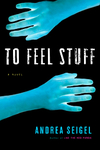Andrea Seigel has done something not very many writers actually achieve: followed up an incredibly exciting first novel with an incredibly exciting second novel That Is Completely Different. If Like the Red Panda was a coming of age story (or a suicide valentine; pair it with Lynda Barry’s Cruddy), then To Feel Stuff is a ghost story about being alive.
Elodie, beset by malady after malady, lives in the college infirmary at Brown. Dr. Mark Kirschling becomes fixated on her as a phenomenon infinitely more fascinating than your typical case study. Chester, who has always been a golden boy, gets attacked and comes to stay in the infirmary; he and Elodie promptly fall in strange, believable love. The novel gracefully interleaves the viewpoints of the good doctor with those of the lovers. Fittingly, Elodie’s version is the richest, because only she truly understands herself and her place in the world. AND she starts to see ghosts, or maybe not exactly. Maybe she’s inherited her mother’s gift, maybe something different. Elodie’s story feels full of ghosts, of history and of what will never be.
And I can say without reservation that this book features two sequences that are undeniably the best of their type in all of fictionland, in the categories of journey in search of waffles and karaoke-gone-wrong. Which points up one of the things I loved about this book, and that’s its easy unexpectedness. Lots of times when books dabble in the kooky side character who brings her bird into work one day or try and achieve a truly off-kilter protagonist (that isn’t just annoying), it’s painfully obvious that making the oddness of life seem normal AND interesting in a way that also feels real is damn hard. Often, it comes across as trite. In trying to capture a more sideways snapshot of what life’s like, the quirky becomes the banal. But that is definitely not the case here. Here, Seigel makes it work in a way that reads as effortless and honest. An oddways reality bounded on all sides by how far the characters can, or can’t, go, outside those infirmary walls and outside themselves. And whether they are, ultimately, okay with where and who they happen to be.
The book’s distinctly distant yet completely absorbing view of the world, like Elodie’s from her own traitorous body, is unnerving in the best possible way.
